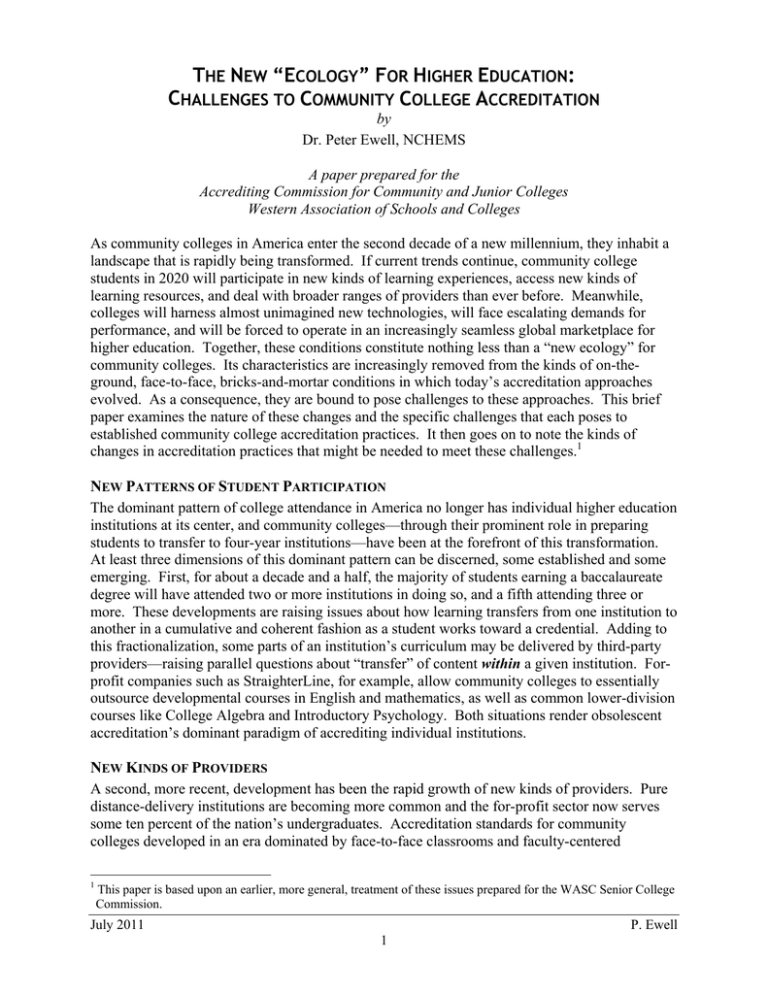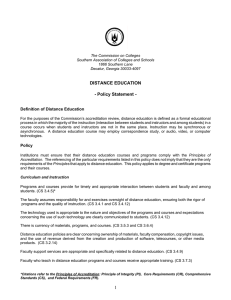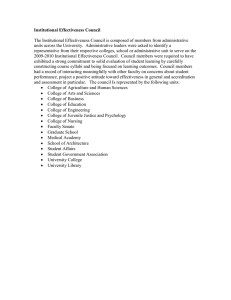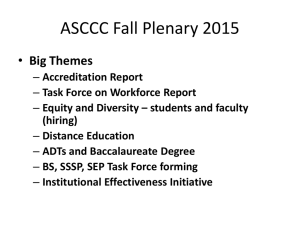T N “E ”
advertisement

THE NEW “ECOLOGY” FOR HIGHER EDUCATION: CHALLENGES TO COMMUNITY COLLEGE ACCREDITATION by Dr. Peter Ewell, NCHEMS A paper prepared for the Accrediting Commission for Community and Junior Colleges Western Association of Schools and Colleges As community colleges in America enter the second decade of a new millennium, they inhabit a landscape that is rapidly being transformed. If current trends continue, community college students in 2020 will participate in new kinds of learning experiences, access new kinds of learning resources, and deal with broader ranges of providers than ever before. Meanwhile, colleges will harness almost unimagined new technologies, will face escalating demands for performance, and will be forced to operate in an increasingly seamless global marketplace for higher education. Together, these conditions constitute nothing less than a “new ecology” for community colleges. Its characteristics are increasingly removed from the kinds of on-theground, face-to-face, bricks-and-mortar conditions in which today’s accreditation approaches evolved. As a consequence, they are bound to pose challenges to these approaches. This brief paper examines the nature of these changes and the specific challenges that each poses to established community college accreditation practices. It then goes on to note the kinds of changes in accreditation practices that might be needed to meet these challenges.1 NEW PATTERNS OF STUDENT PARTICIPATION The dominant pattern of college attendance in America no longer has individual higher education institutions at its center, and community colleges—through their prominent role in preparing students to transfer to four-year institutions—have been at the forefront of this transformation. At least three dimensions of this dominant pattern can be discerned, some established and some emerging. First, for about a decade and a half, the majority of students earning a baccalaureate degree will have attended two or more institutions in doing so, and a fifth attending three or more. These developments are raising issues about how learning transfers from one institution to another in a cumulative and coherent fashion as a student works toward a credential. Adding to this fractionalization, some parts of an institution’s curriculum may be delivered by third-party providers—raising parallel questions about “transfer” of content within a given institution. Forprofit companies such as StraighterLine, for example, allow community colleges to essentially outsource developmental courses in English and mathematics, as well as common lower-division courses like College Algebra and Introductory Psychology. Both situations render obsolescent accreditation’s dominant paradigm of accrediting individual institutions. NEW KINDS OF PROVIDERS A second, more recent, development has been the rapid growth of new kinds of providers. Pure distance-delivery institutions are becoming more common and the for-profit sector now serves some ten percent of the nation’s undergraduates. Accreditation standards for community colleges developed in an era dominated by face-to-face classrooms and faculty-centered 1 This paper is based upon an earlier, more general, treatment of these issues prepared for the WASC Senior College Commission. July 2011 P. Ewell 1 The New Ecology for Higher Education: Challenges to Community College Accreditation approaches to teaching and learning are becoming ill-suited to these new institutions. Looking even farther into the future, some cutting-edge providers are not higher education institutions at all and there is growing availability of learning resources that learners can access on their own. Meanwhile, access to internet-based information resources can potentially allow a dedicated “student” to master all the material contained in a baccalaureate program without attending an organized institution of higher education at all. A TRANSFORMED AND CONTINGENT FACULTY When most community colleges were established in the 1960s-70s, the faculty workforce at all types of institutions was overwhelmingly centered on full-time faculty on a tenure track. Community college faculty, to be sure, have four to five-course teaching loads and no research responsibilities compared to their four-year counterparts, but they are expected to serve as colleagues for one another in developing new courses and curricula, as well as setting academic standards and policies. Full-time availability also meant that most faculty were available to participate in professional development to build their skills in such areas as effective collaborative pedagogy, use of technology in teaching, and assessing student learning outcomes. Since that time, the face of America’s faculty has shifted markedly. About a third of the current professoriate now consists of part-time faculty hired on a contingent basis to staff particular introductory or lower-division courses with high student demand. Meanwhile, growing numbers of those employed full-time are not on a tenure line and remain employed on a contract basis as instructors. These trends are especially prevalent at two-year colleges, where more than half of the total faculty workforce is now part-time and contingent. In the light of accreditation’s heavy focus on the faculty role in designing and approving all aspects of the teaching/learning process, and accreditation’s historic emphasis on the role of faculty in participatory governance, these trends cannot help being disturbing. NEW APPROACHES TO TEACHING AND LEARNING Also fading into history is the traditional academic calendar based on fixed time-based terms (semesters or quarters) and one-way transmission of content. In contrast, the emerging new “paradigm” of teaching and learning is based on a short course or mastery model in which students make academic progress by successfully completing, at their own pace, successive examinations, demonstrations, or performances. Community colleges have been prominent in developing these compressed, accelerated, or mastery-based course formats—especially in their occupational and vocational programs. In contrast to the traditional term-based approach, this model is frequently characterized by a wide diversity of individual learning experiences. In a mastery-based curriculum, for example, not all students will have engaged in the same “curriculum,” although all will be expected to meet common outcomes standards. In an accelerated curriculum, moreover, students may be assessed for their learning styles and assigned different paths through the material that optimize their particular strengths. At the opposite end of the continuum, another feature of this new paradigm of teaching and learning is characterized by far more standardized and structured learning experiences built using a growing body of insights, provided through cognitive science, about how people learn. A prominent example in the community college world is the Center for Academic Transformation’s redesigned course in developmental mathematics, which has realized both cost savings and improved learning gains. By 2020, it is very likely that a majority of the nation’s college students will be experiencing one of these two transformed modes of provision. Both of these approaches effectively “unbundle” the faculty role by separating the functions of course design, content delivery, assessment, and July 2011 P. Ewell 2 The New Ecology for Higher Education: Challenges to Community College Accreditation mentorship. And like the trend toward and increasingly contingent faculty described above, both challenge accreditation’s traditional faculty-centric and resource-based view of quality. CONSTRAINED RESOURCES The current global economic downturn was preceded by a long period of state budgetary shortfalls and consequent disinvestment in public higher education. And available evidence suggests that most states will be in structural deficits throughout the coming decade, even if the economy rebounds more broadly. Growing gaps between rich and poor accompanying these economic trends, moreover, already mean that higher education is unaffordable to growing numbers of students. These conditions increasingly mean that students are attending community colleges instead of incurring unaffordable debt burdens to go to higher priced four-year colleges and universities. Worsening finances also put pressure on accreditation to ensure that institutions are paying proper attention to the stewardship of their fiscal resources for future survival— demanding attention to efficiency as well as effectiveness. Finally, they put pressure on accreditors themselves to make the accreditation process more efficient by reducing duplication, streamlining reporting, and harnessing technology to enable “virtual” presence and collaboration. A GLOBAL HIGHER EDUCATION SYSTEM Finally, the U.S. higher education system is not operating in isolation from those of the rest of the world. Just as students move from institution to institution and state to state with greater frequency, foreign students are coming to the U.S. Community colleges, especially in urban areas, are accommodating an ever larger proportion of these recent immigrants from Mexico and Latin America, the Caribbean, and Asia. Distance delivery is accelerating these phenomena and it is likely that 2020 will be characterized by a “flatter” higher education world. Increased globalization means that academic standards for college-level work are converging across national contexts. The Bologna process in Europe is the most visible manifestation of the emergence of aligned global standards, with counterparts in Australasia, as well as Central and South America. To be acceptable abroad, U.S. standards for student learning outcomes will need to be aligned with these new prototypes and be assessed in similar fashions. A “flattening” world also demands that U.S. college graduates have global competencies including an understanding of other cultures, geographic knowledge, and foreign language skills. One implication is that these should be added to established lists of generic competencies that accreditors require institutions to teach and assess. It is easier to define these emerging changes and identify the challenges they pose to current accreditation practices than it is to delineate the specifics of how these practices ought to change. Nevertheless, these trends suggest the following: Accreditors will need to shift some of their attention toward monitoring how students progress longitudinally toward credentials, using the services of many educational providers. This may require special attention to examining how the increasingly disparate parts of a student’s experience fit together to constitute an effective path to a given credential or degree. How partnerships of two-year and four-year institutions treat, monitor, and evaluate transfer courses as senders and receivers will be an important part of this. In addition, accreditors will need to increasingly recognize—and possibly review—providers such as “outsourced” providers of packaged courses and informational websites. At the very least, they will have to pay more attention to examining the criteria July 2011 P. Ewell 3 The New Ecology for Higher Education: Challenges to Community College Accreditation by which institutions decide to use licensed providers such as these and accept their credits. These trends, as well as the changing paradigm of teaching and learning, will require even more emphasis to be placed on aligned standards of academic achievement, as well as solid evidence that these standards are being achieved. As noted, this will require attention to what the common elements of any associates degree ought to be or what constitutes “transfer ready” in terms of abilities, as well as how colleges are able to set appropriate performance benchmarks on these learning outcomes as “good enough.” Accreditors will require new standards and review approaches to deal with increasingly contingent and “unbundled” faculty roles. Reviewing faculty credentials and how faculty members are deployed will no longer be enough. In addition, attention must be paid to how the scattered and contingent components of the traditional faculty role in the form of adjunct appointments and responsibilities are re-integrated to yield coherent and high quality learning experiences. It should also address how and how well individuals are developed and evaluated in these new roles. Review processes will need to be more visibly cost-effective, employing, where appropriate, more virtual communication and less paper-and-pencil reporting. What reporting remains must be indicator-based and ruthlessly focused on institutional effectiveness and student learning. Accreditors will need to perform a more overt accountability role, with processes more attuned to public concerns about quality, and public participation in the accreditation process through more public members of Commissions and, where appropriate, lay members of review teams. The results of reviews will need to be reported in more detail to external audiences, including summaries of findings and the enumeration of institutional strengths and weaknesses. At the same time, colleges will be increasingly required to make the results of learning outcomes assessment public, together with appropriately-benchmarked levels of student performance. As shown by the past ten years, change can happen quickly and become transformational. After all, tools that we now take for granted, ranging from Google to GoToMeeting, were only invented in that time period. The standards we develop in community college accreditation to anticipate 2020 must anticipate similar rates and directions of change. But they must also be flexible because we cannot anticipate everything. July 2011 P. Ewell 4




